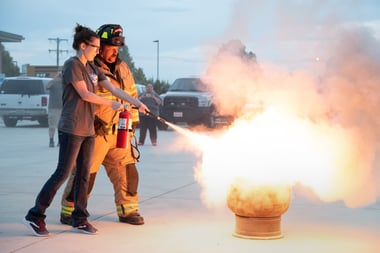
With National Safety Month winding down, it’s important to stay consistent on safety training and drills for your employees. All companies, regardless of industry, need to be able to respond to workplace emergencies in an appropriate manner. To achieve this goal, it is important that companies not only have emergency preparedness plans in place but also train their staff. By training staff members, employees will be prepared to respond to emergencies in the event one arises.
What is emergency response training?
Emergency response training is a type of training conducted to ensure all building occupants are ready for emergency situations. The training is critical to ensure that all employees understand what to do and when to act in the event of an emergency. Without training, a host of issues could arise, including staff becoming panicked.
Emergency Response Training Habits
Each employee needs to specifically know what they are expected to do during different types of emergencies. Here are a few of the basic emergency response training habits every employee can develop.
Evacuation Routes
Some facilities have multiple types of alarms, for instance a fire alarm, but for many facilities, an alarm means that something is wrong, and everyone should evacuate. Every employee should know what the exit routes are and there all exits are located. Every employee should be able to leave a building in at least two different ways.
It’s important that fire and other evacuation drills allow employees to practice using both primary and alternative routes so that they are less likely to panic in the event of an emergency.
Employees also should know where to go after they leave the building and whom to report to after they have evacuated. It’s critical to have a gathering location for all employees and to carry a checklist to ensure all employees made it out safely.
Eyewash Stations and Drench Showers
In industries where chemicals are used, it’s essential to know how to get to and operate eyewash stations. Many companies blindfold employees to see if they can maneuver their way to the eyewash station. The quicker someone gets there to receive treatment, the better the outcome.
Fire Extinguishers
All buildings should have fire extinguishers. Annual fire extinguisher training and drills can help employees understand how to use them and practice the skill. In the event of a fire, things can get hectic, so it’s essential for employees to not only know how to use a fire extinguisher, but also where they’re located throughout the building.
Since all fire extinguishers are inspected and maintained monthly by a fire and life safety company, fire extinguishers should be in working order and ready to assist if a fire arises.
Spill Response
Most spills that happen in businesses are small and can be safely cleaned up by employees in the immediate area. When a spill creates an unsafe atmosphere or threatens the health of employees, it is considered an emergency spill and needs to be cleaned up by employees who have been trained to OSHA's Hazardous Waste Operations and Emergency Response (HAZWOPER) Standard.
All employees need to learn how to quickly determine whether they are capable of cleaning up a spill or need to call trained emergency spill responders. Volume, location, chemical properties, and levels of training are all factors that need to be taken into consideration when training employees how to determine whether a spill is incidental.
First Aid
Businesses that are not located in close proximity to hospitals or medical facilities need to train employee to administer first aid, including CPR, EpiPen, or AED training. While it is not necessary for every employee to receive first aid training, it is important for every employee to know what to do when someone is injured. If all employees do not receive first aid training, it is important for all employees to know who to go to in order to report an injury. Even simple, common sense skills such as being able to retrieve the first aid kit or being able to meet the ambulance at the door and direct them to an injured employee are helpful.
Benefits of Emergency Response Training
By training employees in basic emergency response, they will be prepared to respond to emergencies should one arise. Below are a few benefits of providing employees with basic emergency response training.
-
Helps responders follow prepared emergency protocol. The main goal of emergency response training is to prepare employees to follow the set emergency preparedness plan. This is beneficial as the plans are designed to reduce physical injuries and damage to the building. Emergency preparedness plans provide employees with suitable guidance during emergency situations, and by training, employees will learn how to follow the plan set in handling any unexpected situations effectively.
-
Improve responder confidence. In addition to improving the employee response to workplace emergencies, training can also offer employees a greater level of confidence if they are in an emergency situation. When an employee receives adequate response training, they tend to feel more assured of their capabilities and, potentially, life-saving skills. By being confident, the employee is able to respond to emergencies competently and help any individuals who may be in danger.
-
Empower responders to utilize safety resources. Without the correct type of training, many employees would not be able to utilize the safety equipment provided in the correct way. For example, people who do not understand how to use a fire extinguisher may cause more harm than good in an emergency situation. Fire extinguishers seem to be all the same, but this is a fallacy as different extinguishers are utilized for different types of fires. A water extinguisher would be used on Class A fires, whereas dry powder extinguishers would cause a Class A fire to increase in intensity. All of this can be learned in training.
-
Long-term investment for staff. Providing employees with emergency response training can be seen as a long-term investment. When this type of training is offered, employees can see this as the company showing its loyalty to their team, while also having confidence in their employer that they feel their safety means something.
Few businesses and employees ever have to act out on these responses. But without regular emergency training and drills, the actions will never become familiar and can be of more harm than good. The more comfortable employees are with their roles in emergency response, the more likely they will be to follow established plans and avoid injuries.
Practice makes perfect; the same can be said in regards to emergency response training.




